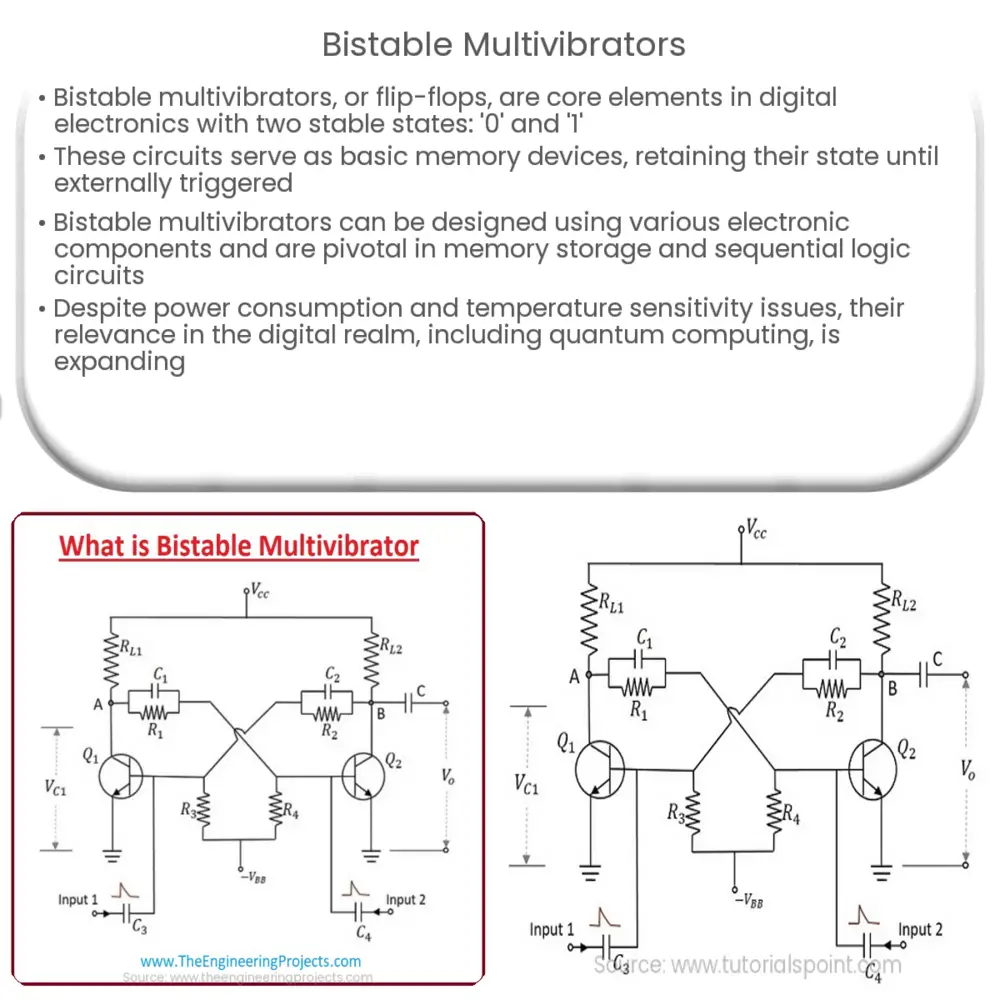Dive into the world of bistable multivibrators, their operation, types, applications, and their pivotal role in digital systems.

Bistable Multivibrators: An Introduction
A bistable multivibrator, also known as a flip-flop, is a fundamental element in digital electronics and computer architecture. It is a type of circuit that possesses two stable states, and is capable of toggling between these states based on the input given.
Principles and Operation
The bistable multivibrator is so named due to its dual 2 stable states. These states are typically denoted as ‘0’ and ‘1’, or ‘ON’ and ‘OFF’, representing the binary data within digital systems. The circuit maintains its current state until an external trigger changes it, making the bistable multivibrator a basic memory device in digital systems.
The essential elements of this circuit include two amplifying devices such as transistors or operational amplifiers, resistors, and capacitors. The components are interconnected in a way that the output of each amplifying device is coupled to the input of the other.
Types of Bistable Multivibrators
- Set-Reset (SR) Bistable Multivibrator: Also known as an SR flip-flop, this is the simplest form of a bistable multivibrator. It consists of two NOR or NAND gates and has two inputs, Set and Reset, and two outputs, Q and Q’. When the Set input is activated, the Q output is ‘1’, and when the Reset input is activated, the Q output is ‘0’.
- JK Bistable Multivibrator: This type of bistable multivibrator is an extension of the SR bistable multivibrator and solves the undefined state issue present in the SR flip-flop. It has two inputs, J and K, and two outputs, Q and Q’. The outputs change based on the different combinations of J and K.
Applications of Bistable Multivibrators
- As an electronic toggle switch, a bistable multivibrator can maintain a state until it’s toggled to the opposite one.
- It is widely used in digital systems for storing binary data, being a core component in memory devices.
- In sequential logic circuits, bistable multivibrators are used to remember the current state and transition to the next state based on input signals.
Design and Functionality
Bistable multivibrators can be designed using different electronic components like BJTs (Bipolar Junction Transistors), FETs (Field Effect Transistors), and even logic gates in digital circuits. As mentioned earlier, they are composed of two amplifying stages cross-coupled to each other, forming a positive feedback loop. This configuration enables the circuit to maintain one of its two stable states until an external trigger initiates a state change.
An important characteristic of a bistable multivibrator is its “trigger sensitivity. In some designs, a very short pulse is enough to toggle the state, whereas, in others, a longer pulse or a continuous signal is required. This characteristic is particularly significant in the design of various digital and memory devices.
Limitations and Considerations
Despite their ubiquity and utility, bistable multivibrators do have limitations. They consume a significant amount of power in comparison to other types of digital circuits, and their performance can be affected by temperature variations. Designers must take these factors into account when using bistable multivibrators in their circuits.
Future Trends
As technology progresses, the role of bistable multivibrators continues to evolve. With the advent of quantum computing, for instance, the principles of bistability are being applied at a quantum level, with qubits acting as quantum flip-flops. This is just one example of how this fundamental concept continues to influence the frontier of technology.
Conclusion
In conclusion, bistable multivibrators form the backbone of many digital systems due to their ability to maintain and toggle between two stable states. From simple electronic switches to complex memory storage systems, they play a crucial role in the world of electronics. Understanding their operation, design, and limitations is vital for anyone interested in electronics or computer architecture. As we move further into the digital age, the importance of these versatile and fundamental devices only continues to grow.

